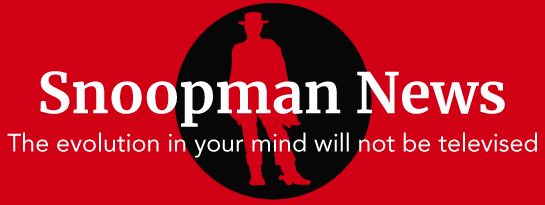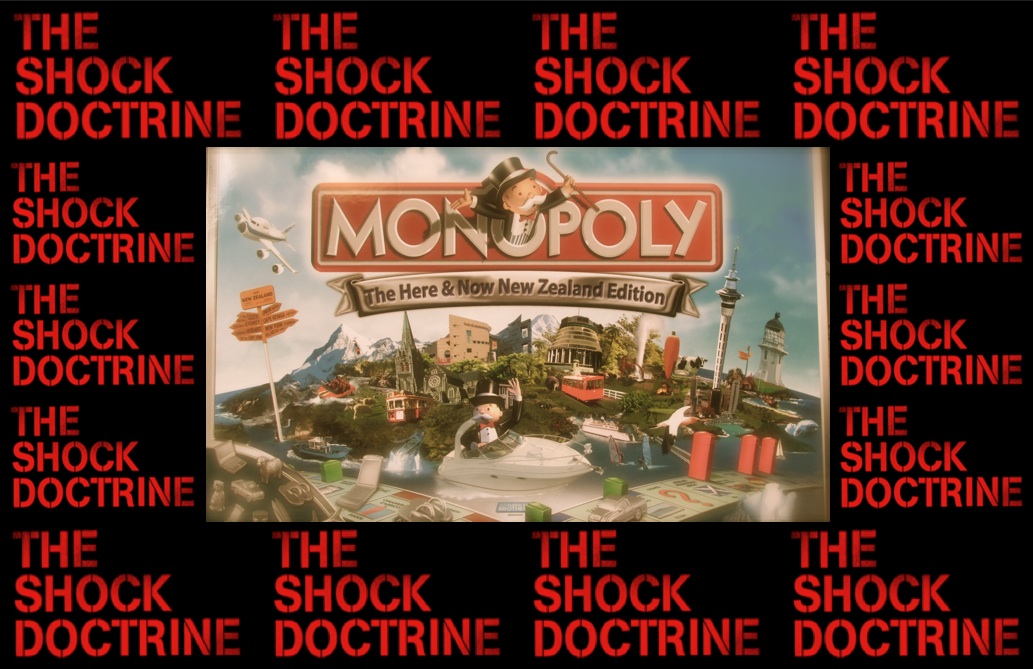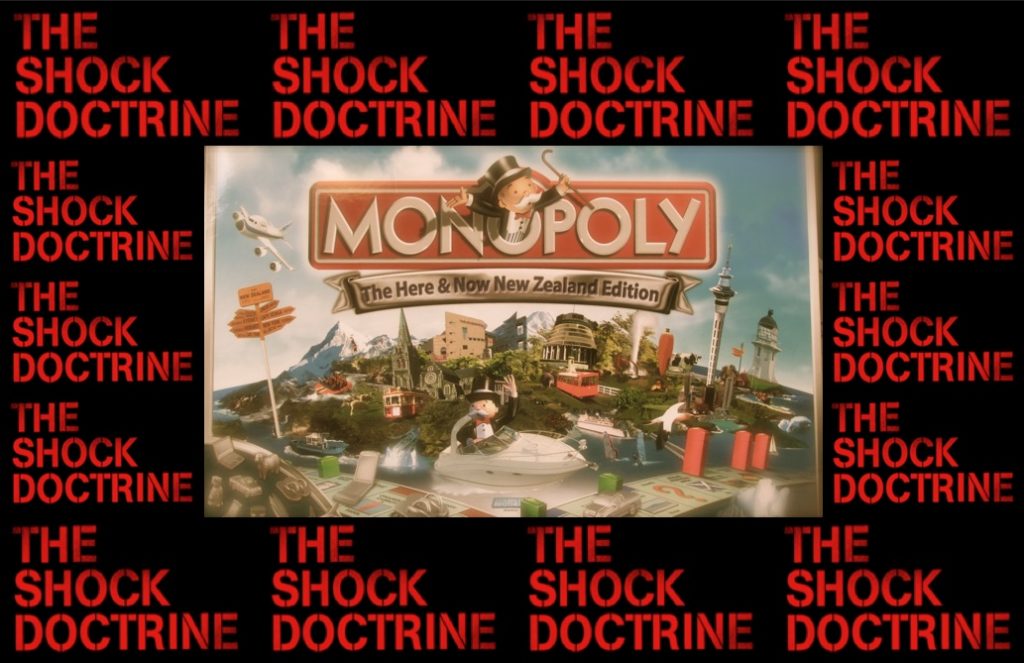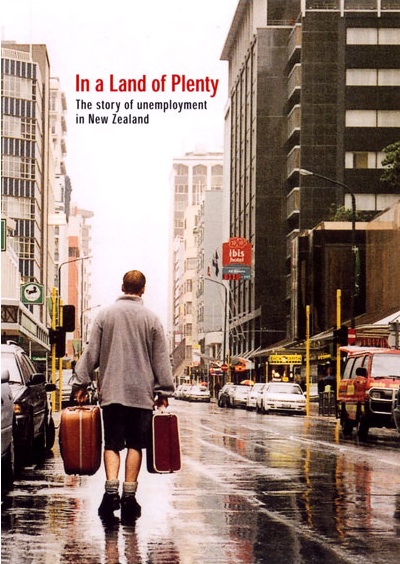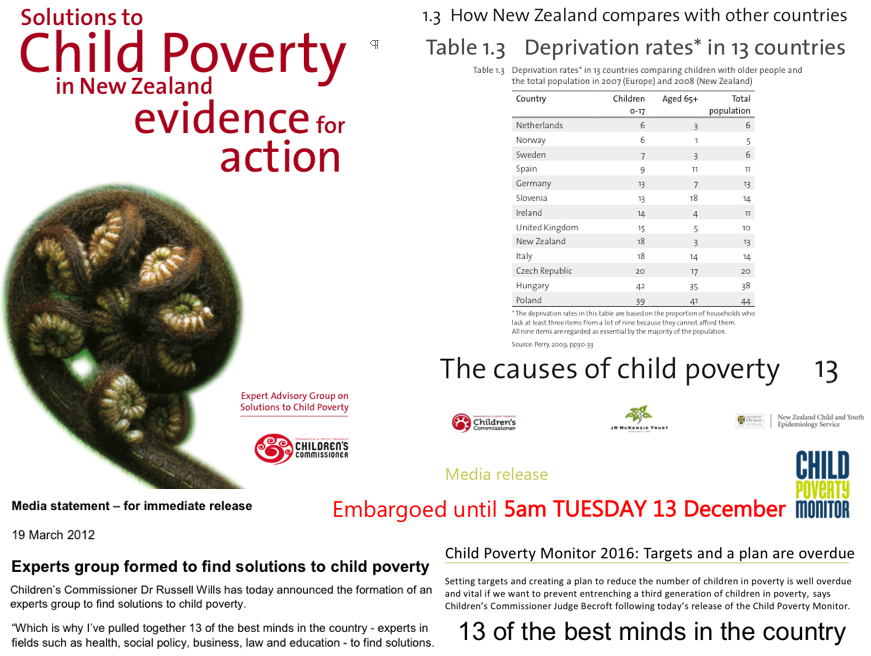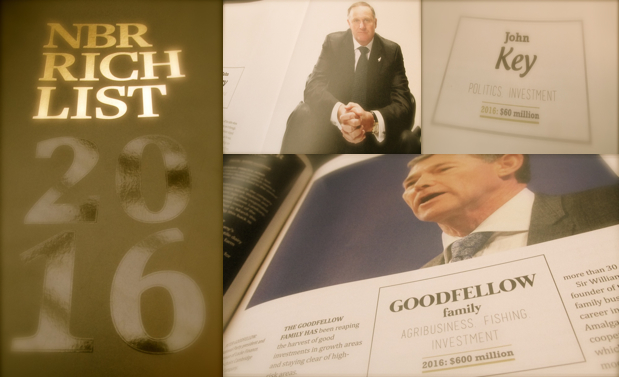Shock Treatments to Re-fence the Realm
Unknown to most New Zealanders, the New Zealand Crown operates a hidden state policy of economic warfare against 99% of its people. The multiple crises that beset New Zealand – including housing unaffordability, poverty and debt – all occur within a secret ‘Shock Doctrine’ narrative.
At a time when Oxfam found that the richest 1% of New Zealanders owned a fifth of the nation’s wealth – while 90 per cent of the population owned less than half[1] – the United Nations found that persistent child poverty afflicts one third of New Zealand children – or 300,000 tamariki.[2] Meanwhile, NZ’s total debt topped half a trillion dollars in June 2017, with the household debt balloon expanding to $250 billion,[3] and The Economist magazine reported New Zealand is ranked the world’s most unaffordable place to live.[4] The current Shock Doctrine trajectory was anchored in the mid-1970s to establish New Zealand as a pre-eminent experimental 1st World Neo-Colonial crisis-ridden society.
Today, the Neo-Colonial Government administrates the still-operational economic warfare policy of structural unemployment. This secret state policy is designed to keep the level of people out of work at a level of around 6% of the labour force. Because huge pools of unemployed people create the visible spectacle of poverty, it works as a coercive mechanism to keep wages and salaries low for big business beneficiaries, as experts such as former Reserve Bank director Suzanne Snively (1985-1992), argued compellingly in Alistair Barry’s documentary, In a Land of Plenty: The Story of Unemployment in New Zealand.[5] Snively stated unemployment was a manageable and easy way for the Reserve Bank to bring down wages and prices, “so, they used it” – amid high inflation.[6] New Zealand had less than 1% registered unemployed in 1973, which peaked at 16 percent in December 1992. In 1991, the unemployment benefit was cut from $144 to $130 a week;[7] $130 – as a multiple of 13 signifies Fraternal ‘unity’.[8]
Structural unemployment was cemented with the Reserve Bank’s inflation-targeting policy. By keeping inflation between 1 to 3% per year, the Reserve Bank supplies cheap international credit to wealthy investors who are free to pursue maximum asset wealth ‘creation’ in an economic environment characterized by asymmetric inflation. Thus, ‘flattened’ labour costs are starkly contrasted with high prices for essentials such as food, power, fuel and housing because all industries are, in fact, dominated cartelized ‘markets’.
Poverty Crisis: A Visible Poor as a Mechanism of Social Submission
Given the forgoing moves by the Neo-Colonial Sect to engineer and control crises, it was not surprising to see that ‘the fix’ was in when an ‘expert group’ was formed to investigate the extent, causes, and solutions of child poverty in New Zealand. Children’s Commissioner Dr Russell Wills’ press statement said he had “pulled together 13 of the best minds in the country”.[9] Curiously, in the “The Causes of Child Poverty” section – which started on page 13 of its ‘final report’ – “Solutions to Child Poverty Solutions to Child Poverty in New Zealand: Evidence for Action,” – the Expert Advisory Group failed to nail New Zealand’s super-rich Civil Oligarchy.[10] Because oligarchs are super-rich people who use their enormous economic resources to steer the political trajectory of whole societies – they can only exist in societies of extreme material inequality, as scholar Jeffrey Winters argued compellingly in his book, Oligarchy.[11] Furthermore, oligarchs thrive in crises-ridden societies and are the root cause of multiple crises inflicted upon the world.[12]Instead of going for the jugular, the 13 experts compared New Zealand with other countries in Section 1.3, finding that poverty affected 13% of the population in a 13-country comparative study.
The curious recurrence of ‘Thirteen’ is disturbing. Thirteen has an occult significance among a ‘Fraternity’, for whom it signals ‘unity and love’. Encoding events with 13 signifies that key players are advancing ‘the game’.
Tiresomely, four years after the final report on Solutions on Child Poverty, a new Children’s Commissioner said he was “shaken” at the extent of child poverty in New Zealand.[13] This statement was part of an embargoed press release, that restricted the news media from publicizing its communiqué until December the 13th 2016[14] – the day after the then-Prime Minister John Key ‘bid farewell’ in the capital city, Hobbiton. This ‘coincidence’ is crucial, because the primary reason Key stone-walled addressing multiple crises that worsened on his watch – including child poverty – was because he is a Rich-Lister.[15] That is, Key is a member of New Zealand’s Neo-Colonial Civil Oligarchy. National Party President Peter Goodfellow is also a Rich-Lister.[16]
The Shock Doctrine Mete-out upon Neo-Colonial New Zealand
The stealthy deployment of ‘free market economic shock treatments’ in New Zealand started under former Prime Minister Robert Muldoon (1975-1984) with large industrial development ‘loans’,[17] liberalizing regulatory controls over the share market,[18] and legislating voluntary union membership.[19] Muldoon led a virtual double-life as chairman of the International Monetary Fund and the World Bank board of governors in 1979 and 1980,[20] which placed him a position to ‘borrow’, and symbolically signaled New Zealand was about to become the First World’s pre-eminent Shock Therapy test lab – without him necessarily knowing it. By 1984, NZ’s total foreign debt was $12 billion, which primed the state apparatus for coercion to submit to the ‘free market’ policy shocks.[21]
The ‘free market’ sect at the New Zealand Reserve Bank and Treasury ‘stipulated’ to the incoming Labour Government in 1984 that the currency needed to be devalued to resolve a ‘currency crisis’ and high inflation. This Neo-Colonial Sect opted to favour high capital mobility and scuttled achieving full-employment. Mont Pèlerin Society political puppet, Finance Minister Roger Douglas, and his troika friends – then-associate finance ministers, David Caygill and Richard Prebble – worked according to a playbook called Economic Management: A Brief to the Incoming Government that was stealthily written by four Treasury officials, including Mont Pèlerin Society member Roger Kerr (and later the NZ Business Roundtable Executive Director). The ‘troika’ readied 13 state assets for sale.[22] At a Mont Pèlerin Society conference in Christchurch in1989, Douglas bragged of his shock therapy modus operandi to overwhelm multiple sectors to the 400 attendees.[23]
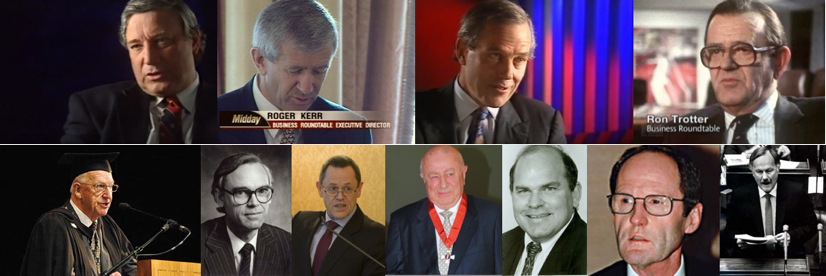 Mont Pelerin Society attendees – Christchurch 1989: [TL to BR] Sir Alan Gibbs, Sir Roger Kerr, Sir Douglas Myers, Sir Ron Trotter, Sir Peter Shirtcliffe, Sir Roderick Deane, Simon Upton, Sir Michael Friedlander, Rodney Hide, Sir David Richwhite & Sir Roger Douglas.
Mont Pelerin Society attendees – Christchurch 1989: [TL to BR] Sir Alan Gibbs, Sir Roger Kerr, Sir Douglas Myers, Sir Ron Trotter, Sir Peter Shirtcliffe, Sir Roderick Deane, Simon Upton, Sir Michael Friedlander, Rodney Hide, Sir David Richwhite & Sir Roger Douglas.
In their 1997 The New Citizen Report,[24] the Australian authors found that the Mont Pèlerin Society was the chief economic warfare unit of the British Crown, and was responsible for planning the “looting and the destruction of the nation-state of New Zealand.” The Society had three New Zealand front groups, foremost the Business Roundtable. Merchant bank CS First Boston’s First NZ Capital produced ‘free market’ reports and lured four Treasury officials, including now-billionaire Stephen Jennings.[25]
Neo-Colonialism: The Last Stage of Imperialism
The impetus for this re-set of the New Zealand Realm and the rest of the world came from the then-North Atlantic Capitalist Class, who faced several major crises. These were a structural crisis of Declining Profit Rates, the numerous peoples’ movements of the 1960s and demands from a Developmentalist Movement in ‘Third’ and ‘Second World’ countries for Western technologies in fair return for the resources they had supplied for the rebuild of Western Europe and Japan following WWII.
To counter these crises, the North Atlantic Capitalist Class developed a ‘free market’ economic warfare framework to transform the world, as Requiem for an American Dream shows.[26] This ‘imperial brain trust’ blueprint – dubbed the ‘1980s Project’ – was first formulated between 1971-1973 at a New York-based think-tank, the Council on Foreign Relations.[27] Key insiders at the Council on Foreign Relations planned the spread of ‘free markets’ by exploiting the concepts of ‘speed, suddenness and scope’, which were field-tested on Brazil, Indonesia, Chile, Uruguay and Argentina using military violence to destroy the Developmentalist Movement.[28] Strategic sabotage of industry ensued.[29]
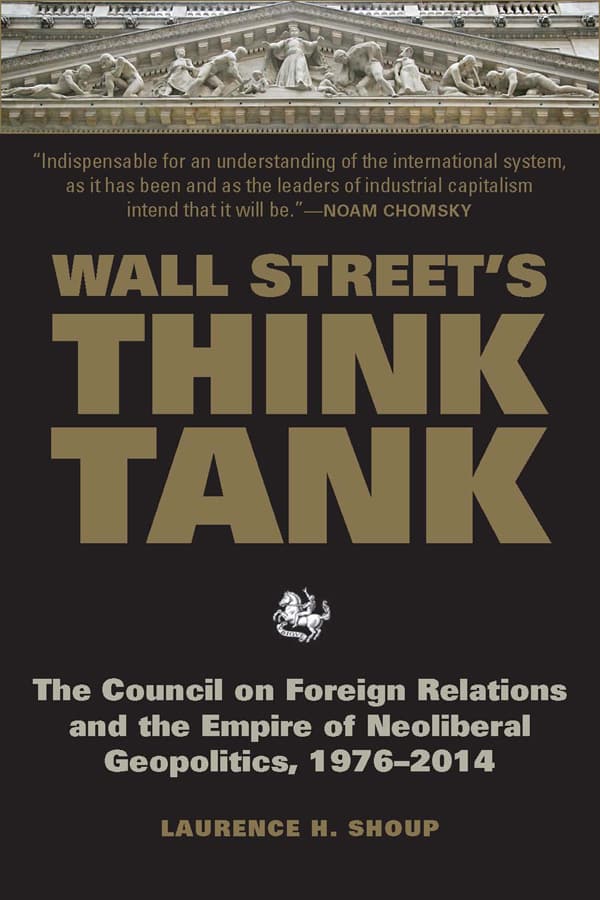
Another think-tank, the Trilateral Commission,[30] was tasked to formulate policies, strategies and tactics to undermine nation state autonomy with this Shock Doctrine modus operandi developed by the Neo-Colonial Sect. To trigger this stealthily engineered game of economic warfare, a Rockefeller-Kissinger-Bilderberger Nexus of conspirators orchestrated the 1970s Oil Price Crisis by plotting the Yom Kippur War of 1973. The plot of Kissinger & Friends was to establish a new “world price for oil”, to re-invigorate the privately-owned US Federal Reserve’s military-backed Petro-Dollar cartel, and to create a world economic crisis with huge ‘borrowings’ to coerce governments to submit to the coming ‘free market’ paradigm: Neo-Colonialism.[31]
In his 1965 book Neo-Colonialism: The Last Stage of Imperialism – former President of Ghana, Kwame Nkrumah, wrote a Neo-Colonial state has the outward appearance of international sovereignty, but because its economic resources and financial systems are controlled from outside, the political apparatus takes external directives.[32] Nkrumah showed the former European colonies of Africa found their hard won political independence was literally undermined by highly interlocked mining, oil and banking consortiums that controlled indigenous economic resources and ran national financial systems. “Neo-colonialism, like colonialism, is an attempt to export the social conflicts of capitalist countries”, wrote Nkrumah, “[and] increases the rivalry between the great powers”. Once a country is captured by Neo-Colonialists, a dynamic is set in motion that compels neighbouring countries to adopt the Neo-Colonial framework.
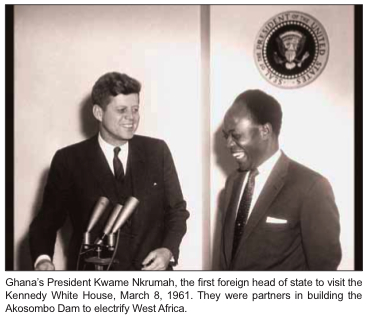 Developmentalist Leaders: Both presidents were pro-development, as historian Anthony Chaitkin explores in a video interview, “JFK vs Empire”.
Developmentalist Leaders: Both presidents were pro-development, as historian Anthony Chaitkin explores in a video interview, “JFK vs Empire”.
[Editor’s Note: The embedding of the number 13 into institutional data does not necessarily mean that the nominal head of the institution is a member of the Fraternity, or that everyone who reproduces such data belongs to the Brotherhood].
Part 1: New Zealand as a Crisis-Ridden Theme Park
Part 2: New Zealand as an Economic War Zone
Part 3: A Secret Brotherhood in GodZone 13
====
Source References:
[1] January 16 2017. Wealth inequality in NZ worse than Australia http://www.stuff.co.nz/business/88439032/two-mens-wealth-equal-to-the-poorest-30-per-cent-of-kiwis-oxfam-research
[2] Newshub staff 08/10/2016 UN ‘deeply concerned’ by New Zealand’s child poverty http://www.newshub.co.nz/home/new-zealand/2016/10/un-deeply-concerned-by-new-zealands-child-poverty.html; Child Poverty Action Group Tuesday, 11 October 2016 UN report on child poverty shows urgent action needed http://www.scoop.co.nz/stories/PO1610/S00160/un-report-on-child-poverty-shows-urgent-action-needed.htm
[3] Liam Dann. (10 June 2017). Kiwis Drowning in Debt, p. C1. The New Zealand Herald.
[4] Liam Dann. (10 June 2017). Nation of Debt: Half a trillion dollars and still rising. Retrieved from: http://www.nzherald.co.nz/business/news/article.cfm?c_id=3&objectid=11873204
[5] Barry, Alistair. (2002). In a Land of Plenty. [Motion Picture]. Vanguard Films. Retrieved from http://www.nzonscreen.com/title/in-a-land-of-plenty-2002 [In 5-part video segments]
[6] Barry, Alistair. (2002). In a Land of Plenty. [Motion Picture]. Vanguard Films. Retrieved from http://www.nzonscreen.com/title/in-a-land-of-plenty-2002 [In 5-part video segments]; See also: Barry, Alistair. (1995). Someone Else’s Country. [Motion Picture]. Vanguard Films. Retrieved from http://www.nzonscreen.com/title/someone-elses-country-1996
[7] Max Rashbrooke. (2013). Inequality and New Zealand, p. 29. In: Inequality in New Zealand. Wellington; NZ: Bridget Williams Books.
[8] Aleister Crowley. (1986). Liber 777, xxv; “An Essay Upon Numbers”. In: Israel Regardie (Ed.). (1994). 777 and Other Qabalistic Writings of Aleister Crowley, p.29. York Beach, Maine; USA: Samuel Wesier Inc.; W. Wynn Westcott. (1911). Numbers: Their Occult Power and Mystic Virtues, p.109
[9] Experts group formed to find solutions to child poverty. Children’s Commissioner. www.victoria.ac.nz/sog/about/publications/Child-Poverty-Media-Statement.pdf
[10] Expert Advisory Group Solutions to Child Poverty Solutions. (December 2012). “Solutions to Child Poverty Solutions to Child Poverty in New Zealand: Evidence for Action.” http://www.occ.org.nz/assets/Uploads/EAG/Final-report/Final-report-Solutions-to-child-poverty-evidence-for-action.pdf
[11] Winters, J. A. (2011a). Oligarchy. New York: Cambridge University Press.
[12] Webster Griffin Tarpley. (n.d.). Against Oligarchy. Retrieved from: tarpley.net/online-books/against-oligarchy/
[13] Christina Campbell (13 December 2016). Children’s commissioner ‘shaken’ by extent of child poverty in NZ. http://www.newstalkzb.co.nz/news/national/childrens-commissioner-shaken-by-extent-of-child-poverty-in-nz/
[14] Media release Child Poverty Monitor 2016 – Office of the Children’s Embargoed until 5am TUESDAY 13 December, Child Poverty Monitor 2016 www.occ.org.nz/assets/Uploads/FINALCPMMedia-release2016.pdf
[15] Graham Adams. (15 March, 2016). Is John Key the finest actor of his generation? http://www.noted.co.nz/currently/politics/opinion-is-john-key-the-finest-actor-of-his-generation/
[16] NBR Rich List 2016. The National Business Review Rich List Index. Ranked Alphabetically, p. 12, 57, 204. National Business Review.
[17] Robert Muldoon and the New Zealand economic crisis, 1975-84, p. 10-15. https://apebhconference.files.wordpress.com/2009/08/mcaloon1.pdf
[18] Revolution: Part One – Fortress New Zealand https://www.youtube.com/watch?v=JZXpeUQ0tD8
[19] John Roughan (3 August 2005). July 1984: When life in NZ turned upside down. Retrieved from http://www.nzherald.co.nz/john-roughan/news/article.cfm?a_id=5&objectid=3576219
[20] Notable New Zealanders: The Pictorial Who’s Who, p. 332. First Edition. Auckland: Paul Hamlyn Limited; Eric Pace (5 August 1992). Sir Robert Muldoon Is Dead at 70; Ex-New Zealand Prime Minister http://www.nytimes.com/1992/08/05/world/sir-robert-muldoon-is-dead-at-70-ex-new-zealand-prime-minister.html; Simon Walker. (6 August 1992). Obituary: Sir Robert Muldoon http://www.independent.co.uk/news/people/obituary-sir-robert-muldoon-1538341.html
[21] Kelsey, Jane. (1995). The New Zealand Experiment: A World Model for Structural Adjustment? Pluto Press.
[22] Alistair Barry. (2008). The Hollow Men. [Documentary]. Retrieved from www.nzonscreen.com/title/the-hollow-men-2008; Barry, Alistair. (2002). In a Land of Plenty. [Motion Picture]. Vanguard Films. Retrieved from http://www.nzonscreen.com/title/in-a-land-of-plenty-2002 [In 5-part video segments]; See also: Barry, Alistair. (1995). Someone Else’s Country. [Motion Picture]. Vanguard Films. Retrieved from http://www.nzonscreen.com/title/someone-elses-country-1996; Jane Kelsey. (1993). Rolling Back the State, p.47
[23] Douglas, Roger. (1993). Unfinished Business, p. 221 Auckland; New Zealand: Random House.
[24] Robert Barwick et al. (January-March, 1997). Her Majesty’s Mont Perelin Society assaults New Zealand, p. 6-11. In: Nazi ‘reforms’ rip apart New Zealand – Australia Next. The New Citizen Report. Vol.4, No. 7. Citizens Electoral Council, Australia.
[25] NBR Rich List 2016. The National Business Review Rich List Index. Ranked Alphabetically, p. 47. National Business Review.
[26] Peter D. Hutchison and Kelly Nyks. (2015). Requiem for the American Dream: Noam Chomsky and the Principles of Concentration of Wealth & Power. Retrieved from: https://www.youtube.com/watch?v=j9asVtLFxpU
[27] Shoup, L. H. & Minter, W. (2004 [1977]). Imperial Brain Trust: The Council on Foreign Relations and United States Foreign Policy, 254-284. New York, NY: Authors Choice Press; Shoup, L. H. (2015). Wall Street’s Think Tank: The Council on Foreign Relations and the Empire Neoliberal Geopolitics, 1976-2014. New York: Monthly Review Press.
[28] Klein, Naomi. (2007). The Shock Doctrine: The Rise of Disaster Capitalism. Camberwell, Australia: Penguin Books; Whitecross, M & Winterbottom, A. (Directors) & Eaton, A. (Producer). The Shock Doctrine 2009 [Motion picture] Retrieved from https://www.youtube.com/watch?v=v6yceBTf_Vs;; Pilger, J. (2002). The New Rulers of the World. London: Verso; Pilger, J. & Lowry, A. (2001). The New Rulers of the World, Carlton Television, Pinkus, Karen. “Nothing from Nothing: Alchemy and the Economic Crisis.” World Picture 2.
[29] Nitzan, J. & Bichler, S. (2009). Capital as Power: A Study of Order and Creorder. New York, NY: Routledge. Retrieved from: bnarchives.yorku.ca/259/2/20090522_nb_casp_full_indexed.pdf; Tim DiMuzio (28 November 2013). The Weekly Sabotage: Week 1. Capital as Power. http://www.capitalaspower.com/2013/11/the-weekly-sabotage-week-1/
[30] Peter D. Hutchison and Kelly Nyks. (2015). Requiem for the American Dream: Noam Chomsky and the Principles of Concentration of Wealth & Power. Retrieved from: https://www.youtube.com/watch?v=j9asVtLFxpU
[31] Engdahl, W. (2004). A Century of War: Anglo-American Oil Politics and the New World Order (Rev. ed.). London, England: Pluto Press; Engdahl, F. W. (2009). Gods of Money: Wall Street and the Death of the American Century. Wiesbaden, Germany: edition.engdahl; Estulin, D. (2009). The True Story of the Bilderberg Group (North American Union ed.), p. 183-184. Walterville, OR: Trine Day LLC; Eustace Mullins. (1991). The Secrets of Federal Reserve” The London Connection. United States. Bridger House Publishers Inc.; Colonel L. Fletcher Prouty: The Origin ofFossil Fuel & Peak Oil. Retrieved from: https://www.youtube.com/watch?v=2cUg3lDgJ20
[32] Kwame Nkurumah. (1965). Neo-Colonialism: The Last Stage of Imperialism. London, United Kingdom: Nelson.
